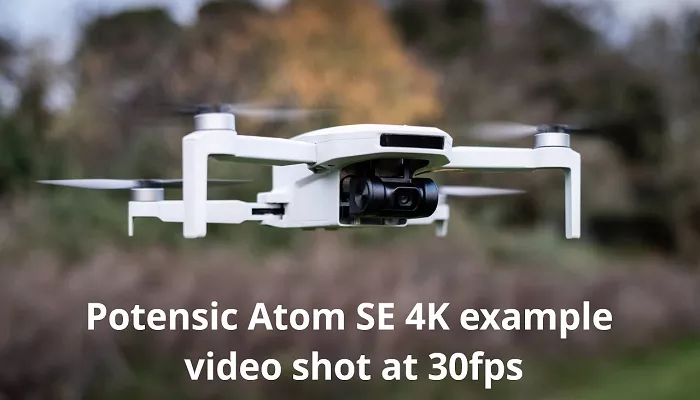The Potensic ATOM SE is a compact and lightweight drone that has garnered attention for its impressive features and affordability. One of the most common questions among drone enthusiasts and potential buyers is: “How high can the Potensic ATOM SE fly?” In this comprehensive guide, we’ll delve into the technical specifications, flight capabilities, and legal considerations surrounding the ATOM SE’s maximum altitude.
Potensic ATOM SE Overview
Before diving into altitude limits, let’s look at what makes this drone special:
-
Weight: Under 249g (no FAA registration required in the US).
-
Camera: 4K/30fps with 3-axis stabilization.
-
Flight Time: Up to 31 minutes (industry-leading for its class).
-
Range: 4 km (with strong signal transmission).
-
GPS & Auto Return Home: Ensures safety if the drone loses connection.
The ATOM SE is designed for portability, ease of use, and high-quality aerial shots—making it a top choice for travelers and hobbyists.
What is Drone Altitude: Key Terms
Before exploring the ATOM SE’s capabilities, it’s essential to understand some key terms related to drone altitude:
- Maximum Flight Altitude: The highest altitude a drone can reach above its takeoff point, as defined by the manufacturer.
- Maximum Takeoff Altitude: The highest elevation above sea level from which a drone can safely take off and operate.
- VLOS (Visual Line of Sight): A regulatory requirement mandating that drone pilots must always maintain visual contact with their drone during flight.
Potensic ATOM SE: Maximum Flight Altitude
According to Potensic’s official specifications, the ATOM SE has a maximum flight altitude of 120 meters (approximately 394 feet). This limitation aligns with many countries’ aviation regulations, including those in the United States and Japan, which often restrict drone flights to 120 meters above ground level to ensure airspace safety.
This altitude is sufficient for various applications, including aerial photography, videography, and recreational flying. However, it’s crucial to note that exceeding this altitude can lead to legal consequences and potential safety hazards.
Potensic ATOM SE: Maximum Takeoff Altitude
The ATOM SE is designed to operate at high elevations, boasting a maximum takeoff altitude of 4,000 meters (approximately 13,123 feet) above sea level . This feature is particularly beneficial for users in mountainous regions or high-altitude areas, ensuring reliable performance even in challenging environments.
However, while the drone can take off from such elevations, the maximum flight altitude from the takeoff point remains at 120 meters. Therefore, even at higher elevations, pilots must adhere to the 120-meter flight ceiling above their takeoff location.
Factors Influencing Flight Altitude
Several factors can influence the ATOM SE’s ability to reach and maintain its maximum flight altitude:
1. Battery Life
The ATOM SE offers a maximum flight time of 31 minutes under optimal conditions . Flying at higher altitudes or in windy conditions can drain the battery more quickly, potentially reducing flight time and limiting the drone’s ability to reach its maximum altitude.
2. Weather Conditions
Wind, temperature, and air pressure can affect the drone’s performance. For instance, strong winds can make it challenging to ascend or maintain altitude, while low temperatures can impact battery efficiency.
3. Payload
While the ATOM SE is not designed to carry additional payloads, any extra weight can affect its ascent rate and overall flight performance.
4. Firmware and Software Settings
Some drones have customizable settings that allow users to set altitude limits. Ensuring that these settings align with the drone’s capabilities and local regulations is essential for safe operation.
Legal Considerations
Adhering to local aviation regulations is paramount when operating drones. In many countries, including the United States, Canada, and Japan, the maximum allowable altitude for drone flights is 120 meters (400 feet) above ground level. Exceeding this limit can result in fines, legal action, or other penalties.
Additionally, pilots must always maintain Visual Line of Sight (VLOS) with their drone, ensuring they can see and control it throughout the flight. Flying beyond VLOS is prohibited in many jurisdictions and can pose significant safety risks.
Enhancing Flight Experience Within Legal Limits
While the ATOM SE’s maximum flight altitude is capped at 120 meters, pilots can still optimize their flying experience:
1. Utilize Intelligent Flight Modes
The ATOM SE offers various intelligent flight modes, such as Circle Flight, GPS Tracking, and Waypoint Flight, allowing for creative and dynamic aerial shots without exceeding altitude limits.
2. Plan Flights in Open Areas
Flying in open spaces free from obstructions like tall buildings or trees can provide unobstructed views and safer flight paths, enhancing the overall experience.
3. Monitor Battery Levels
Keeping an eye on battery levels ensures that the drone has sufficient power to return safely, especially when flying at higher altitudes within the permitted range.
Potensic ATOM SE vs. Competitors: Altitude Comparison
| Drone Model | Max Altitude (Software Limit) | Legal Limit (USA/EU) |
|---|---|---|
| Potensic ATOM SE | 500m (1,640 ft) | 122m (400 ft) |
| DJI Mini 4 Pro | 500m (1,640 ft) | 120m (394 ft) |
| Autel EVO Nano+ | 800m (2,625 ft) | 120m (394 ft) |
| Holy Stone HS720E | 300m (984 ft) | 122m (400 ft) |
The ATOM SE performs similarly to the DJI Mini 4 Pro in altitude limits but at a more affordable price.
Conclusion
The Potensic ATOM SE is a versatile and user-friendly drone, offering a maximum flight altitude of 120 meters and a maximum takeoff altitude of 4,000 meters above sea level. These specifications make it suitable for a wide range of applications, from recreational flying to professional photography, especially in high-altitude regions.
By understanding and adhering to local regulations, considering environmental factors, and utilizing the drone’s intelligent features, pilots can maximize their flying experience while ensuring safety and compliance.


